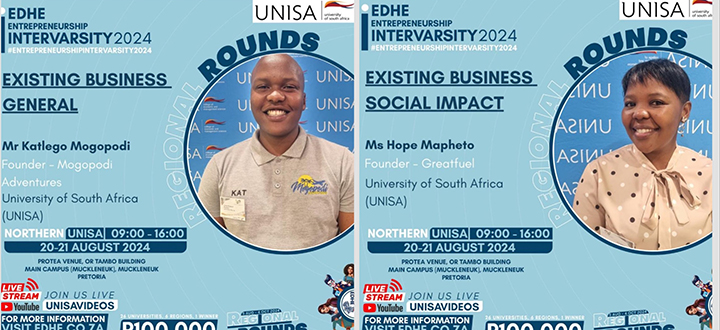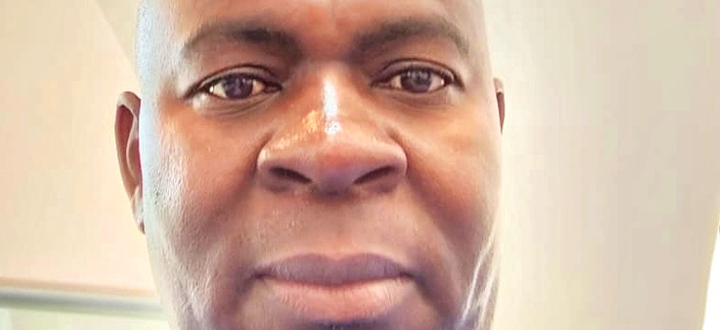College of Science, Engineering & Technology
Innovators win ISP grants
Innovative ideas deserve support, especially when the originators are Unisa’s own staff. This is the thinking behind the Innovation Support Programme (ISP), run by the Directorate: Innovation and Technology Transfer (DITT), which announced the names of the 2016 recipients of financial grants intended to help them take their innovations further.
Last year, there were only two ISP recipients: Bojane Segooa, Senior Lecturer in Financial Accounting in the College of Accounting Sciences, and Prof Lukas Snyman, Director of the School of Engineering in the College of Science, Engineering and Technology.
Both successfully presented their ideas to a 10-person panel of adjudicators, who selected them from a group of seven other candidates for grants of up to R100 000 each.

Bojane Segooa, (Senior Lecturer: Financial Accounting in the College of Accounting Sciences).
An app and a happy coincidence
“Life can be so fortuitous,” says Segooa. “I had hit a dead-end with funding for my project, which I had been self-funding, and was walking around on campus, moping, when I saw a poster for the Innovation Support Programme. It said the programme supports novel ideas that solve a societal problem, so I applied.”
Her grant-winning project is an app, branded “LEVELSAPP”, which helps grade 10 to 12 learners make better, more informed study choices. It does this by aggregating details of every undergraduate degree from all South African universities onto a single, user-friendly database.
“The user registers on the app, inputs their academic results and selects a faculty of preference. LEVELSAPP then produces the result, showing all the undergraduate degrees that the learner qualifies to study at all South African universities – public, private and comprehensive,” Segooa says. “The result includes duration of studies, total cost of tuition and entry requirements.”
The inspiration behind the app
To the best of her knowledge, no similar app exists in South Africa, making her LEVELS APP unique – and very much needed. “It’s crushing to see brilliant children not developing themselves and not being developed because they don’t know what to study.”
She refers to her own experience while volunteering as a lecturer to fourth-year Auditing students on the School of Accounting’s bursary programme for disadvantaged students.
“There were very gifted children in the room but some of them were there by default. Unfortunately, because of their circumstances, they didn’t know what to study or where. One student from Limpopo, with 90% for matric maths and science, ended up in my class even though he hated accounting. Why? By default.”
So strongly did Segooa feel about giving young people the opportunity to make more informed choices that she dug into her own pocket to pay a developer and career guidance counsellor to help her develop LEVELSAPP.
“Now, with the funding from the Innovation Support Programme, it will be possible to enhance the app in a way I might not have been able to on my own. I will be able to take LEVELSAPP to the next level.”

Prof Lukas Snyman (Director of the School of Engineering in the College of Science, Engineering and Technology).
Extreme optimist ticks faster when inventions work
As a self-described “extreme optimist who believes in attaining the impossible”, Snyman, the other 2016 recipient, was not content with entering only one project for the Innovation Support Programme. He submitted three, and all three made the grade with the adjudication panel.
This isn’t unexpected, perhaps, considering his prolific history as an inventor, physicist, mathematician and electronic engineer: in the past 15 years, he has been the main inventor in 10 patent applications in international countries including United States, Korean and European patents, and 10 in South Africa, some of which have been granted. “To create and see something work for the first time makes me tick much faster,” he says, explaining his love of inventing.
Here is a summary of each of his three Innovation Support Programme projects.
Harnessing the winds of change
Conventional wind energy systems are huge, costly and also quite inefficient, with a small capture efficiency of the total available energy per cross-sectional area. (In other words, the blades capture only a small percentage of the wind they come into contact with). “My students and I have designed a small wind turbine with innovative blade design that can capture up to 90% of wind energy,” Snyman says. This system is intended to be installed on the rooftops of households, and has an innovative charging system for leading energy into the household at low cost. “We anticipate putting it into the market for just over R1000.” This low-cost wind generation system will be especially viable in large coastal cities like Cape Town and Port Elizabeth where high-intensity wind prevails, he says.

This futuristic micro-grid electricity production system is envisaged by Snyman and students for future South African and African applications. The system can generate enough electricity to run a household completely off the electricity supply grid.
Thanks to the innovative electronic charging and control mechanism, the system is completely self-sustaining and does not draw on any energy source other than the wind. “It should be able to meet most of a household’s energy needs,” says Snyman. The system’s blades are only a few metres in diameter, compared to the 50-metre diameter blades of conventional turbines, and can even be made from scrap metal.
Here comes the sun, with a difference

A prototype thermal energy-to-electricity convertor and electronic control system as developed by Snyman and students.
Snyman’s second project is another rooftop-based, low-cost energy invention, this time using thermal energy from the sun. It’s designed to convert thermal energy to electricity at a much lower cost than conventional photovoltaic systems.
“With conventional systems, only a small part of the solar spectrum is used, and the cost currently runs up to about R5 per kilowatt hour over a 20-year period, compared to the R2 per KW hour we pay for Eskom power. At the School of Engineering at Unisa, we have recently filed a patent application for the technology which will utilise the full spectrum of sunlight, with an anticipated cost of 30 cents per KW hour over a 20-year period, including the capital outlay.”
This technology uses a special “thermal absorber” on rooftops, where it collects the thermal energy and stores it in a conventional household geyser. Once in the geyser, the thermal energy is converted into electricity for household use by means of a special hi-tech-based “thermal energy to electricity converter and an electronic control unit”.
“The thermal-to-electricity conversion device can run 24 hours a day, seven days a week. Even at night, your geyser will convert the thermal energy into electricity. It’s a low-cost solution – no expensive battery systems are used – and it is safe,” Snyman says.
Using one geyser in this way could supply all the hot water a household needs (bear in mind that heating water typically accounts for up 60% of household electricity costs). The other 30% for lighting and TV could be supplied by using a second geyser for thermal-to-electricity conversion, he says. “Ultimately, you could run your house completely independently of the grid using this technology”.
Move over WiFi, here comes LiFi
Everyone with a mobile phone knows about WiFi, but if Snyman has his way, LiFi will be the next big evolution in data communications. The “Li” stands for light, and entails using optical technology on microchips to process and communicate data at a dazzling 10 gigabytes per second.
Known as “photonics on chip”, this project is a hi-tech initiative “just to show that we as South Africans can also do hi-tech and make an international contribution”, says Snyman, whose personal research interest is the photonics-on-chip industry, with 30 articles in international journals in the past 15 years.
Apart from supporting next-generation communications such as LiFi, photonics on chip opens up new possibilities for optical technology applications such as bio-sensing. Simply put: “By placing a chip on your skin, it can read vital parameters like blood pressure, heart rate and sugar levels – directly on chip.”
Snyman is also imagining a world where microchips and a multitude of sensors will be used to sense parameters such as light levels, ambience and pollution levels in future. “One of the big future challenges will be controlling ambient conditions, especially with heat waves and rising pollution levels, and also controlling dedicated technologies to counteract pollution levels. Photonics on chip technology could play an important role in helping us deal with such challenges.”
The Innovation Support Programme is an annual programme open to all Unisa staff members and is aimed at supporting the development of innovative projects. For more information about the 2017 Call for Applications please email the DITT (ditt@unisa.ac.za)
*By Clairwyn van der Merwe
Publish date: 2017-01-18 00:00:00.0


 Cream of the crop – Unisa scientists ranked among the world's top 2%
Cream of the crop – Unisa scientists ranked among the world's top 2%
 Nonkululeko Malomane flies the Unisa flag at FameLab final
Nonkululeko Malomane flies the Unisa flag at FameLab final
 Unisa students claim victory in EDHE Intervarsity Competition
Unisa students claim victory in EDHE Intervarsity Competition
 Unisa AI innovators lead engaging webinar on AI-infused module design
Unisa AI innovators lead engaging webinar on AI-infused module design
 Recognition for Unisan’s journey of decolonising African epistemology
Recognition for Unisan’s journey of decolonising African epistemology
